Prepare to be amazed by the breathtaking Khumbu Glacier Valley! Tucked away in the heart of the majestic Himalayas, this valley is a thrilling wonderland of adventure and natural beauty. Get ready to witness some of the most famous peaks in the world, including the mighty Mount Everest, Lhotse, and Nuptse.
Whether you’re an adrenaline junkie, a trekking enthusiast, or simply someone who loves to marvel at the wonders of nature, this region has something for everyone! Get ready to embark on an unforgettable journey with us as we explore all the incredible experiences that the Khumbu Glacier Valley has to offer.
Location
The Khumbu Glacier Valley is located in the Solukhumbu region of Nepal, which is in the northern part of the country. The valley is situated at an elevation of around 5,000 meters above sea level and is surrounded by the towering peaks of the Himalayas. The valley is accessible via a flight to the town of Lukla, which is often referred to as the gateway to the Khumbu region.
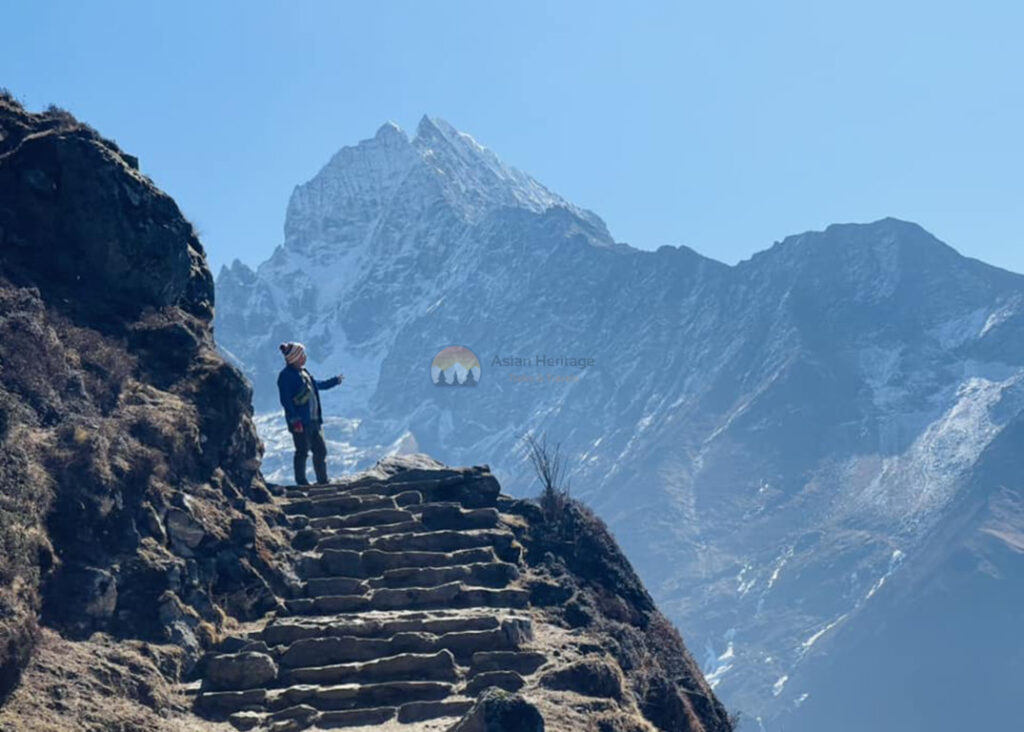
From there, trekkers and adventurers can embark on a thrilling journey through the valley, passing through small villages like Namche Bazaar and Tengboche, before reaching the base of Mount Everest. The location of the Khumbu Glacier Valley is truly unique, offering visitors a once-in-a-lifetime opportunity to witness the awe-inspiring power of nature in all its glory.
Kathmandu to Khumbu Valley
The Khumbu Valley is located in the northeastern part of Nepal and is home to the famous Mount Everest. To access the Khumbu Valley from Kathmandu, you will need to take a flight or drive to the town of Lukla which is the gateway to the region.
By Flight:
Flying to Lukla is the most popular way to access the Khumbu Valley. The Tenzing-Hillary Airport in Lukla is a small airport that sits at an elevation of 2,800 meters (9,186 feet). It’s known for its short runway, which is just 527 meters (1,729 feet) long and has a gradient of 12%. Due to the airport’s location and the unpredictable weather conditions in the region, flights to Lukla can sometimes be delayed or canceled. However, most airlines operate daily flights to Lukla during the peak trekking season from September to November and from March to May.

The flight from Kathmandu to Lukla takes about 30-45 minutes and offers spectacular views of the Himalayan mountain range, including Mount Everest. The flight route passes through narrow valleys and over high mountain passes, making it an exciting and scenic experience. Once you land in Lukla, you can start your trek to the Khumbu Valley.
By Drive:
Driving from Kathmandu to the town of Jiri and then trekking to Lukla is another way to access the Khumbu Valley. The drive from Kathmandu to Jiri takes about 8-10 hours and is a bumpy and winding road. From Jiri, you can trek through the beautiful SoluKhumbu region to reach Lukla, which takes about 7-10 days. The trek from Jiri to Lukla is known as the classic trek to Everest Base Camp and is a popular alternative to flying. This route offers a chance to explore the traditional villages, terraced fields, and stunning landscapes of the SoluKhumbu region. However, it is a longer and more challenging trek than the flight option.
Once you reach Lukla you can start your trek to the Khumbu Valley. The trek takes you through beautiful Sherpa villages including Namche Bazaar which is the gateway to the Khumbu Valley. You’ll also cross High Mountain passes including the famous Cho La Pass and have the opportunity to explore the stunning mountain scenery of the region. The trek to Everest Base Camp takes about 12 to 14 days depending on your itinerary and fitness level.
Weather
The weather in this region is highly variable and can be unpredictable due to the mountainous terrain and the altitude. In general, the Khumbu Glacier Valley experiences a high-altitude alpine climate, characterized by cold temperatures and low humidity levels. The temperature can drop below freezing at night, even during the summer months, and the daytime temperature typically ranges from 10 to 20 degrees Celsius (50-68 degrees Fahrenheit).
The weather in the Khumbu Glacier Valley is heavily influenced by the monsoon season, which typically occurs from June to September. During this time, the valley receives heavy rainfall which can lead to flooding and landslides. The monsoon season can also cause clouds to obscure the mountain peaks making it difficult for climbers to navigate.
Also Read: Everest Base Camp Challenges: A Troubleshooting Guide
In the winter months, from December to February, the Khumbu Glacier Valley experiences cold and dry weather, with occasional snowfall. The average temperature during this time ranges from -10 to 5 degrees Celsius (14-41 degrees Fahrenheit).
Lifestyle at Khumbu Valley
The Khumbu Valley is a unique region located in northeastern Nepal known for its stunning mountain peaks and rich Sherpa culture. The lifestyle in this region is heavily influenced by the mountain environment and the traditional Sherpa culture. The Sherpas, a major ethnic group in the Khumbu Valley have a strong connection to the mountains and practice a harmonious relationship with nature. Their culture has been shaped by the mountain environment and is characterized by a deep respect for the mountains, Tibetan Buddhism, and traditional festivals.
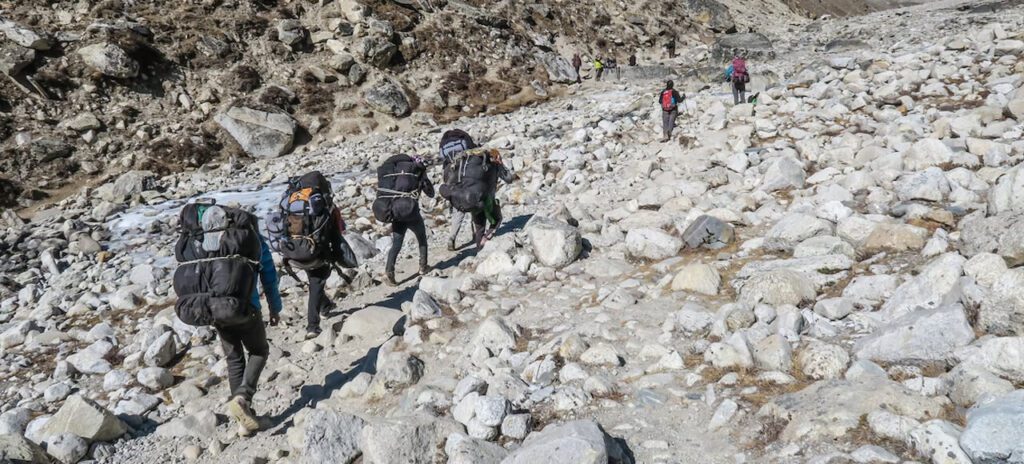
Food in the Khumbu Valley is simple yet nutritious and made up of locally sourced ingredients. The Sherpas rely heavily on agriculture and animal husbandry for their food supply with crops such as potatoes, barley, and buckwheat, and animals such as yaks.

They also harvest wild herbs and mushrooms from the mountains. Clothing in the Khumbu Valley is designed to withstand the cold and harsh climate, with the Sherpas wearing traditional chubas made from woolen fabric, and trekking tourists wearing down jackets, hats, gloves, and boots.
Highlights
The Khumbu Glacier Valley, located in the Sagarmatha National Park of Nepal, is a popular destination for trekkers and climbers who come to experience the breathtaking beauty of the Himalayan Mountains. Here are some highlights of the Khumbu Glacier Valley:
Mount Everest:
One of the main highlights of the Khumbu Glacier Valley is Mount Everest, the world’s highest peak. The mountain is a major attraction for climbers and adventurers who come to test their limits and experience the thrill of reaching the summit. The trek to Everest Base Camp which starts from the Khumbu Glacier Valley is a popular activity for tourists who want to experience the majesty of the mountain without attempting to climb it.
Khumbu Icefall:
Another highlight of the Khumbu Glacier Valley is the Khumbu Icefall which is a treacherous section of the route to Mount Everest. The icefall is known for its unstable ice and crevasses, and climbers must navigate it carefully to avoid danger. The Khumbu Glacier, which feeds into the icefall, is also a remarkable natural feature, with its massive ice formations and blue-green hues.
You may also like: Everest Base Camp in January
Sherpa Culture:
The Khumbu Glacier Valley is home to the Sherpa people who boast a deep cultural heritage. Tourists can immerse themselves in Sherpa culture by visiting nearby monasteries and villages. Namche Bazaar, the main settlement in the Khumbu region is a popular stop for trekkers seeking to gain insight into Sherpa culture. Additionally, visitors can explore the renowned Tengboche Monastery, a spectacular Buddhist temple that offers stunning views of Mount Everest and its environs.
Namche Bazar:
Visitors to Namche Bazaar can engage in other activities such as mountain biking, rock climbing, and helicopter tours of the region. The village also hosts a weekly market on Saturdays where locals sell their goods including fresh produce, handmade crafts, and traditional clothing. It is also a popular stopover for trekkers on their way to Everest Base Camp.
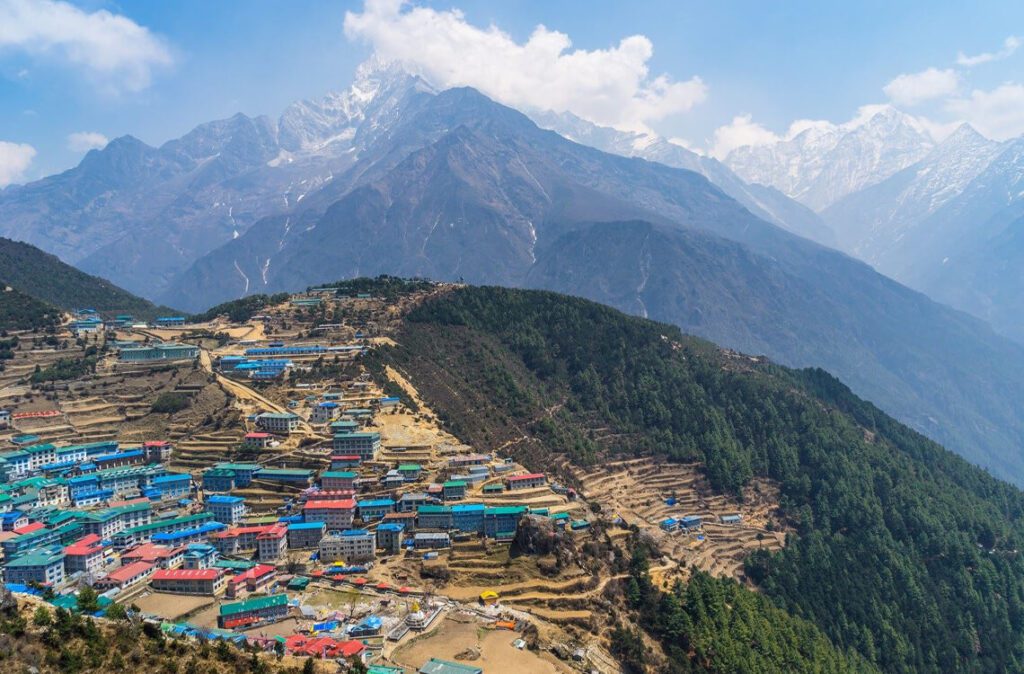
Many trekkers spend a few days in Namche Bazaar to acclimatize to the altitude before continuing their journey. There are many trekking routes that start from Namche Bazaar including the route to the Gokyo Lakes and the Everest View Trek which offers stunning views of Mount Everest and the surrounding mountains.
Gokyo Lakes:
The Gokyo Lakes are a noteworthy attraction located in the Khumbu Glacier Valley consisting of six glacial lakes. These lakes are well-known for their shimmering waters and stunning panoramic views of the neighboring mountains. Although the trek to reach the Gokyo Lakes can be challenging, it is undoubtedly worth the effort as it passes through some of the most awe-inspiring landscapes on Earth.
Tengboche Monastery:
Tengboche Monastery is a renowned Buddhist monastery situated in the Khumbu region of northeastern Nepal within the Sagarmatha National Park. It is situated at an altitude of 3,867 meters (12,687 ft) and offers breathtaking views of the snow-capped peaks of the Himalayas, including Mount Everest which is visible on clear days. The monastery is an integral part of the local Sherpa community who have been living in the region for centuries.
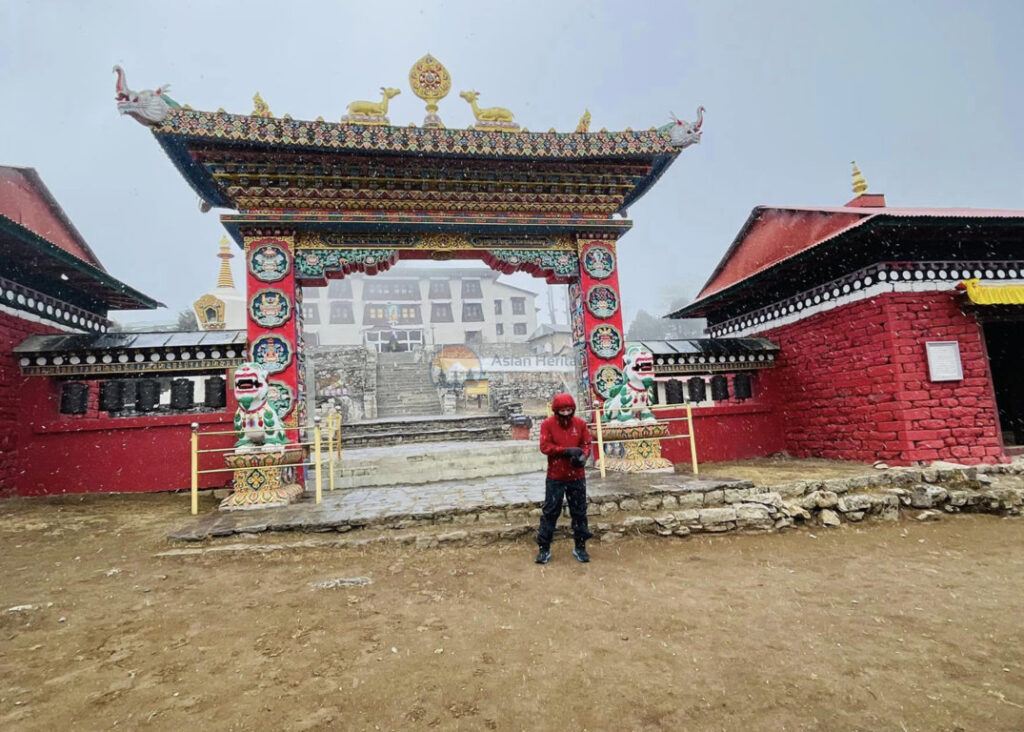
Tengboche Monastery is a popular destination for trekkers and mountaineers who often stop here to rest and acclimatize before continuing on their journey towards Mount Everest Base Camp or other high-altitude destinations in the region. The monastery is located on the Everest Base Camp Trek which is one of the most famous treks in the world and is a highlight for many visitors.
Everest Base Camp:
The Khumbu Glacier Valley is the starting point for the trek to Everest Base Camp. The trek is a challenging but rewarding experience that takes visitors through some of the most stunning landscapes in the world.
Khumbu Glacier Valley Trek
The Khumbu Glacier Valley Trek is a popular route for trekkers in Nepal located within the Sagarmatha National Park, a UNESCO World Heritage Site. During the trek, you’ll journey through the Khumbu Valley where you’ll encounter some of the highest peaks in the world, including Mount Everest, Lhotse, and Nuptse.
Your journey will commence with a scenic flight from Kathmandu to Lukla followed by a walk to Namche Bazaar, a bustling Sherpa town. As you continue up the valley, you’ll pass through several hamlets and monasteries before reaching Gorak Shep, the base of Mount Everest. For breathtaking views of the Himalayas, you can opt to trek to Kala Patthar from here.
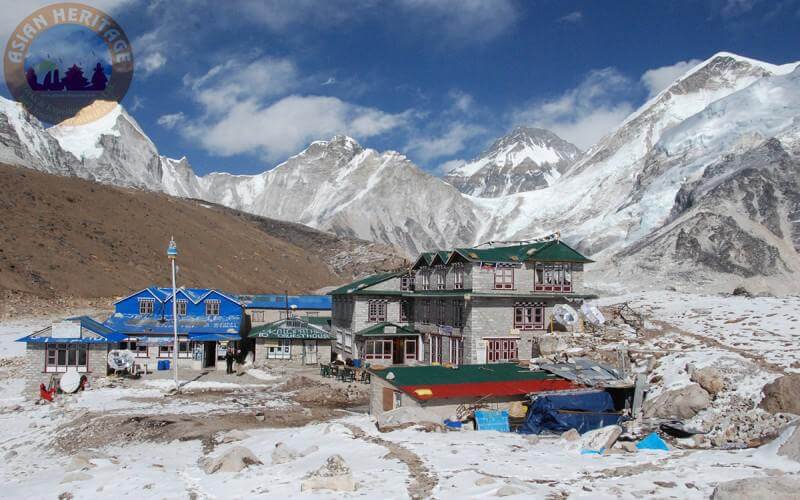
The Khumbu Glacier Valley Trek is a challenging trek that requires a good level of fitness and acclimatization due to the high altitude. You’ll be trekking at elevations above 4,000 meters, so it’s important to take the necessary precautions and follow a proper acclimatization schedule to avoid altitude sickness.
Flora and Fauna
The Khumbu Glacier Valley which is situated in the Solukhumbu district of Nepal is a beautiful valley that offers a wide range of diverse flora and fauna. The region’s unique geographical location and high altitude create an environment that is particularly suited for the growth of alpine vegetation.
Flora
The lower altitudes of the valley are dominated by dense forests of rhododendron, oak, and birch trees. The rhododendrons are particularly beautiful and add a vibrant splash of color to the landscape when they bloom during the spring season. These forests provide a natural habitat for a variety of bird and animal species. As one moves higher up the valley, the tree line recedes and the landscape is replaced by alpine meadows and tundra.

The alpine meadows are particularly stunning during the summer months when they are carpeted with an array of colorful wildflowers. These meadows provide grazing land for a variety of herbivorous animals, including Himalayan tahr and musk deer.
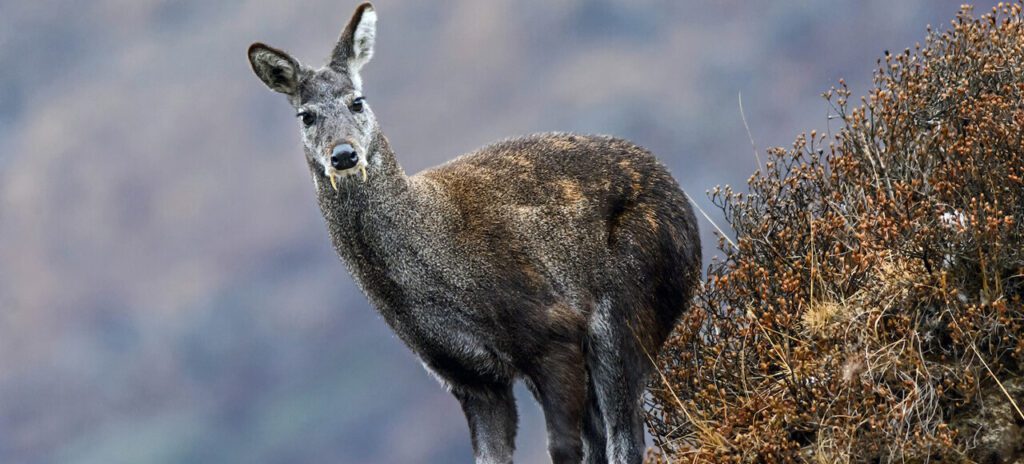
The valley is also home to a variety of medicinal plants that are widely used in traditional Ayurvedic medicine. The Himalayan blue poppy, in particular, is a sought-after plant, known for its medicinal properties. The plant’s roots are used to treat fever, cough, and bronchitis while the flower is used to treat eye problems.
Fauna
One of the most iconic animals of the region is the snow leopard. This elusive cat is one of the rarest and most endangered big cats in the world with an estimated global population of around 4,000. The Khumbu region is home to a small but stable population of snow leopards which are well adapted to the harsh mountain environment. However, sightings of this majestic animal are rare and it takes a lot of patience and luck to spot one.

The Khumbu area is also known for its Himalayan tahr population. These wild goats are commonly spotted grazing on the steep slopes of the valley, as they are perfectly adapted to mountainous terrain. The tahr’s thick fur coat enables them to withstand the cold temperatures prevalent in the alpine environment.
The Khumbu region is also home to other animal species such as the musk deer, Himalayan black bears, and Himalayan marmots. The musk deer which is solitary and elusive is hunted for its musk which is used in traditional medicine. In contrast, black bears are a common sight in the region and are often observed foraging for food in the forests.
Himalayan Marmot
The Khumbu region is home to the Himalayan marmot, a cute and cuddly-looking rodent that lives in underground burrows in the alpine meadows. These sociable animals are well-known for living in large colonies, adding a fun and playful aspect to the region’s wildlife.
The area is also rich in bird species such as the Himalayan monal, snow partridge, and Himalayan pheasant. The monal, in particular, is a strikingly attractive bird with iridescent feathers that shimmer in the sunlight making it a must-see for bird enthusiasts.







